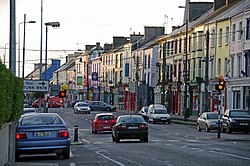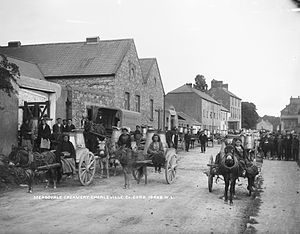Charleville, County Cork
| Charleville Gaelic: Ráth Luirc | |
| County Cork | |
|---|---|
 Charleville town centre | |
| Location | |
| Grid reference: | R530230 |
| Location: | 52°21’18"N, 8°41’2"W |
| Data | |
| Population: | 3,672 (2011[1]) |
| Post town: | Charleville |
| Postcode: | P56 |
| Local Government | |
Charleville is a town in the north of County Cork, within the East Riding. It lies in the Golden Vale, on a tributary of the River Maigue, near the border with County Limerick. Charleville is on the N20 road and is the second-largest town between Limerick and Cork (Mallow is the largest). The Roman Catholic parish of Charleville is within the Diocese of Cloyne. Significant industries in the town include Kerry Co-Op and the construction and services sectors.
Contents
Names
The old name for the place was Rathcogan, later Rathgogan or Rathgoggan,[2][3] the last (Irish: Ráth an Ghogánaigh) still the name of the civil parish around the town.[4] The name means Cogan's rath (ringfort), after the family of Miles de Cogan, granted lands there after the 12th-century Norman invasion.[2][3] The new town begun by Roger Boyle, 1st Earl of Orrery in 1661 was named Charleville after Charles II, who had been restored to the throne the previous year. Later Irish speakers referred to the town as An Ráth "the rath", a short form of the older Irish name.[3] The name Irish: Ráth Luirc ["Lorc's rath"] was first attached to Charleville in an 1849 collection of 18th-century Irish-language poems with English translations.[n 1] The translation of an aisling by Conchúbhar Máistir Ó Ríordáin interpreted Irish: 'Ráth Loirc' as denoting the town of Charleville. T. F. O'Rahilly felt that Irish: 'Ráth Loirc' , like the more common Irish: 'Clár Loirc', was a poetic name for Ireland.[2] D. A. Binchy felt the term, also used by Aogán Ó Rathaille, did refer to a specific place, but likely somewhere in Muskerry, not Charleville.[2][3][5][6] After the 1920 local elections, Sinn Féin-dominated councils loyal to the self-proclaimed Irish Republic often sought to replace placenames having British monarchic allusions with older Gaelic names. Although Rathgoggan was mooted by Charleville Rural District Council, Risteárd Ó Foghladha ["Fiachra Eilgeach"] advised that Ráth Luirc was the old name, and it was changed to Rathluirc in 1920.[2][3][7] Ó Foghladh claimed Lorc was an ancient king of Munster;[8] in fact Lóegaire Lorc was a mythical High King of Ireland.[2] The Placenames Commission was established in the 1940s to systematically determine the authentic Irish names of places, and based on its advice that An Ráth was the commonly-used name among the last generations of local Irish-speaker, this was legally made the Irish name in 1975.[9] Thus the town had the anomalous position that its English-language legal name was an Irish name different from its Irish-language legal name. The name "Charleville" remained in common use.[7] In December 1989, a plebiscite of residents under the Local Government Act 1946 voted on four names: of 2200 electors, 1500 voted, over 90% for Charleville.[10][11][12] Official documents before and after 1989 have often used "Rathluirc (Charleville)" or similar formulations. Local sports teams have a rath or fort in their crest, reflecting the Irish name.
History
Charleville was founded in 1661 by Roger Boyle, 1st Earl of Orrery. Roger Boyle had been a supporter of Oliver Cromwell in the English Civil War. When King Charles II was restored in 1660, he had to prove his loyalty to the crown. He did this by naming Charleville after the king. The villages of Brohill and Rathgoggin, who in their former guise preceded the formation of the town of Charleville in the area, fell under the rule of the following political entities: the Eoghanachta of southern Munster, at some point by the Hiberno-Norman Lordships of Ireland 1169–1541 although this rule was nominal rather than actual and subsequently by the Kingdom of Desmond 1118 – 1596. The lands of Broghill and Rathgogan were purchased by Roger's father Richard Boyle as a part of the Plantation of Munster and Roger subsequently established his residency there after the founding of Charleville.
During the time of the Penal Laws, practising the Catholic faith was illegal. As a result, the parish of Charleville was amalgamated with the parishes of Bruree and Colmanswell, both in the Diocese of Limerick. In 1704, Fr. Daniel Mac Namara of Bruree was registered as the Catholic priest for this very large pastoral area.[13] The fact that Catholics had to attend Mass secretly meant that the old chapel in Holy Cross cemetery was abandoned. The remains of this church – now overgrown with ivy – are still to be seen in the centre of the graveyard. Indeed, like so many other pre-1700 churches, the old church of Holy Cross literally became part of the surrounding graveyard, in that several gravestones, both marked and unmarked, are to be found within the building itself. Upon one such gravestone is a Latin epithaph to none other than Seán Clárach Mac Domhnaill (1691–1754), who was, in his time, the Chief Poet of Munster, as well as a native of Charleville.
Geography
Charleville is geographically located at 'the heart of Munster', within the Golden Vale region. It is 37 miles from Cork city to the south and 25 miles from Limerick city to the north.
Because of its strategic location, Charleville is a convenient location for distribution centres for the Munster region. In 2007, Lidl set up their Munster distribution centre here.
Economy
Charleville is a centre for the food processing industry, with brands such as Charleville Cheese and Golden Vale produced by Kerry Co-Op.
Numerous spin-offs both in the town of Charleville and the surrounding area were created when Golden Vale Engineering closed its doors in 1983. The largest amongst these were BCD Engineering, Diamond Engineering and Sapphire Engineering. BCD is the second largest employer in Charleville.
Golden Vale (part of the Kerry Group) continue to make cheese products in the town. Golden Vale is the largest employer in Charleville.
Charleville has numerous pubs as well as two theatre facilities and is home to the North Cork Drama Festival which is held in the Parochial Hall. The second facility is the Schoolyard Theatre which is home to the Shoestring Theatre group.
Transport
Charleville is at the junction of the N20 national road and the R515 regional road.[14][15] The N20 runs north–south from Limerick to Cork,[14] the R515 east–west from Tipperary to near Abbeyfeale.[15] The R578 runs from Charleville to Ballydesmond.[15] Charleville is on bus routes from Cork – Limerick – Shannon Airport – Galway and Limerick – Charleville.[16] It is 40 miles from both Cork Airport and Shannon Airport.
Charleville railway station is on the Dublin–Cork railway line. It opened in 1849 on the Great Southern and Western Railway. The former Cork–Limerick line branched off the Cork–Dublin line at Charleville, continuing via Croom; the final goods train ran in 1976, since when Limerick Junction, already the junction for Dublin–Limerick, has also been the junction for Cork–Limerick.[17]
Sport
- Charleville A.F.C.
- Ráth Luirc GAA Club
- Charleville Camogie Club
- Charleville RFC
- Charleville Golf Club
- Charleville Pitch and Putt Club
- Ráth Luirc GAA Sports Centre(Squash, badminton and tennis facilities)
- Handball Court
Places of interest
- Charleville Library – is an example of a historic building which has been put into use again after years of neglect. It was formally the Protestant Church of the Parish but went into disrepair in the 1950/1960s when the Protestant population of the area declined.
People
- Normal Place of Residence of Seán Clárach Mac Domhnaill (1691–1754), Chief Poet of Munster who was born in nearby Churchtown
- Birthplace of William Reeves (1815–1892), antiquarian, bishop, and President of the Royal Irish Academy
- Daniel Mannix (4 March 1864 – 6 November 1963), Archbishop of Melbourne for 46 years, and one of the most influential public figures in 20th-century Australia, was born near Charleville.
- Birthplace of Con Leahy (27 April 1876 – 18 December 1921); an Irish athlete, who won Olympic medals at the 1906 and 1908 Games.
- Birthplace of Eliza Lynch, former first lady of Paraguay.[18]
- Keith Hanley, winner of The Voice of Ireland series 2.
- Tony Whitehead, Professional Footballer
Footnotes
Outside links
| ("Wikimedia Commons" has material about Charleville, County Cork) |
References
- ↑ "Census 2011 – Volume 1 – Population Classified by Area" (PDF). Central Statistics Office Census 2011 Reports. Central Statistics Office Ireland. April 2012. http://www.cso.ie/en/media/csoie/census/documents/census2011vol1andprofile1/Census%202011%20-%20Population%20Classified%20by%20Area.pdf. Retrieved 10 August 2012.
- ↑ 2.0 2.1 2.2 2.3 2.4 2.5 2.6 D. A. Binchy (1962). "The Old Name of Charleville, Co. Cork". Éigse (National University of Ireland) 10 (3): 211–35.
- ↑ 3.0 3.1 3.2 3.3 3.4 3.5 Ó Maitiú, Pádraig (26 June 1978). "The old name of Charleville". Cork Examiner.
- ↑ "An Ráth/Charleville". Placenames Database of Ireland. http://www.logainm.ie/en/12021. Retrieved 22 May 2015.
- ↑ Ó Cróinín, D. A. (1964). "The Old Name of Charleville, Co. Cork". Éigse (National University of Ireland) 11 (1): 27–33.
- ↑ Mangan, James Clarence (1850). "Conor O'Sullivan's Vision". in John O'Daly (in Irish, English). The poets and poetry of Munster (2nd ed.). Dublin. p. 118. http://babel.hathitrust.org/cgi/pt?id=hvd.32044011806668;view=1up;seq=140.
- ↑ 7.0 7.1 "Pro-Quidnunc" (22 December 1978). "An Irishman's Diary". The Irish Times: p. 9.
- ↑ "Roddy the Rover" (21 March 1947). "Ráth Luirc" (JPG). Scéala Éireann. http://www.logainm.ie/Iomhanna/box%20100/PAN129662_3.JPG.
- ↑ "I.R. Uimh. 133/1975 — An tOrdú Logainmneacha (Foirmeacha Gaeilge) (Uimh. 1) (Postbhailte) 1975." (in Irish). Irish Statute Book. pp. An Sceideal; Cúige Mumhan; Contae Chorcaí. http://www.irishstatutebook.ie/1975/ga/si/0133.html. Retrieved 22 May 2015.
- ↑ Hogan, Dick (11 December 1989). "King Charles wins handsome majority". p. 4.
- ↑ Ferrie, Liam (17 December 1989). "Bits and Pieces". The Irish Emigrant. http://emigrant.scoilpac.com/index.php?option=com_content&task=view&id=36890&Itemid=18. Retrieved 22 May 2015. "The people of the north Cork town of Rath Luirc (or Charleville, or An Rath, or Rathgoggan) have voted to use the name Charleville for their town. Road signs in the area will be replaced."
- ↑ "S.I. No. 31/1956 - Local Government (Changing of Place Names) Regulations, 1956.". Irish Statute Book. http://www.irishstatutebook.ie/1956/en/si/0031.html. Retrieved 26 May 2015.
- ↑ 'From Bruree to Corcomohide' by Mainchín Seoighe
- ↑ 14.0 14.1 "S.I. No. 53/2012 - Roads Act 1993 (Classification of National Roads) Order 2012.". Irish Statute Book. http://www.irishstatutebook.ie/2012/en/si/0053.html. Retrieved 26 May 2015.
- ↑ 15.0 15.1 15.2 "S.I. No. 188/2006 - Roads Act 1993 (Classification of Regional Roads) Order 2006". Irish Statute Book. http://www.irishstatutebook.ie/2006/en/si/0188.html. Retrieved 26 May 2015.
- ↑ "Network Map" (PDF). Bus Éireann. http://www.buseireann.ie/pdf/1360856510-NetworkMap.pdf. Retrieved 26 May 2015.
- ↑ "Charleville station" (PDF). Railscot – Irish Railways. http://www.railscot.co.uk/Ireland/Irish_railways.pdf. Retrieved 31 August 2007.
- ↑ Tom Hennigan: "Life of Cork woman and heroine in Paraguary to be featured in TV drama", Irish Times, 14 May 2011. (confirmed by baptismal certificate)
